Sitting across from me as I cruise down Highway 1 is a hulking Mitu Monteiro filling out the bucket seat of my full size truck. My job today is part journalist/photographer, part tour guide and part unexpected concierge. I had planned on scoring an early session at Waddell, but Mitu had requested we stop off at a tackle shop outside of San Francisco’s city limits. Mitu talks in creoled-out broken English with a laid-back island style. English is just one of Mitu’s six languages, self-taught from years of running a destination kite school on his home island in Cabo Verde.
As we pull into the tackle shop, I glance at my dash clock and we’re already late, but Mitu has a relaxed sense of time, and it reminds me to stop hawkishly checking the iKitesurf numbers on my phone and chill myself out. We duck into the cavernous tackle shop, and Mitu becomes a young boy loose in a candy store. He schools me on shiny lures, vibrantly colored rubber squids, carbon rods and complicated windy reels. There’s pure passion in his words, which makes me think fishing sits somewhere even with kitesurfing in Mitu’s soul. H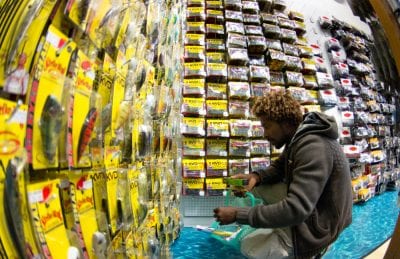 is affinity for fishing feels like a great litmus test of a true waterman ”” Mitu is not just another shallow surf rat ”” he is perhaps more a vestige of a childhood surrounded by water and waves in a much simpler place.
is affinity for fishing feels like a great litmus test of a true waterman ”” Mitu is not just another shallow surf rat ”” he is perhaps more a vestige of a childhood surrounded by water and waves in a much simpler place.
Back in the truck and safely pointed down the coast, I probe Mitu for his life story. He tells me of a modest single parent upbringing and the early years of learning to surf, windsurf and kite, challenged not by a lack of talent but the ability to get his hands on equipment. I want to know about his kite school, his wife and his son and how he’s made a life out of kiteboarding. I’m often jaded by the impression that success in kitesurfing is hard to come by, but Mitu is both heavily traveled and speaks with the voice of someone whose found a simple and rewarding balance in the athleticism and commerce of kitesurfing.
Where was your first tube ride (where did your mom drop you off) and how did you get your start kitesurfing?
I am from Sal Island, Cabo Verde. I grew up in Santa Maria ”” it used to be just a small fisherman village, but now it’s more touristic. All my sports started from growing up there. When I was a kid in school everybody played soccer, but I just took my own path: go to the sea, play in the water or catch some fish. On the sea no problem, I can do everything, but on the soccer field it just wasn’t for me.
What was family life like in Santa Maria?
My mom worked as a chef and for her my fascination with the sea was not so easy. When I was young she had to go to work and I would be alone in the house because I had no one to stay with me. I didn’t know how to swim but I liked to play in the sea and once when I was about five years old I had to be rescued by fishermen. They brought me back to my house and my mom was really scared because she almost lost me. Now I have my son and I understand how it feels to worry, but we’ve started teaching our boy how to swim at a young age, and now he plays in the waves with a lot of confidence and it’s less stress for us living on the beach.
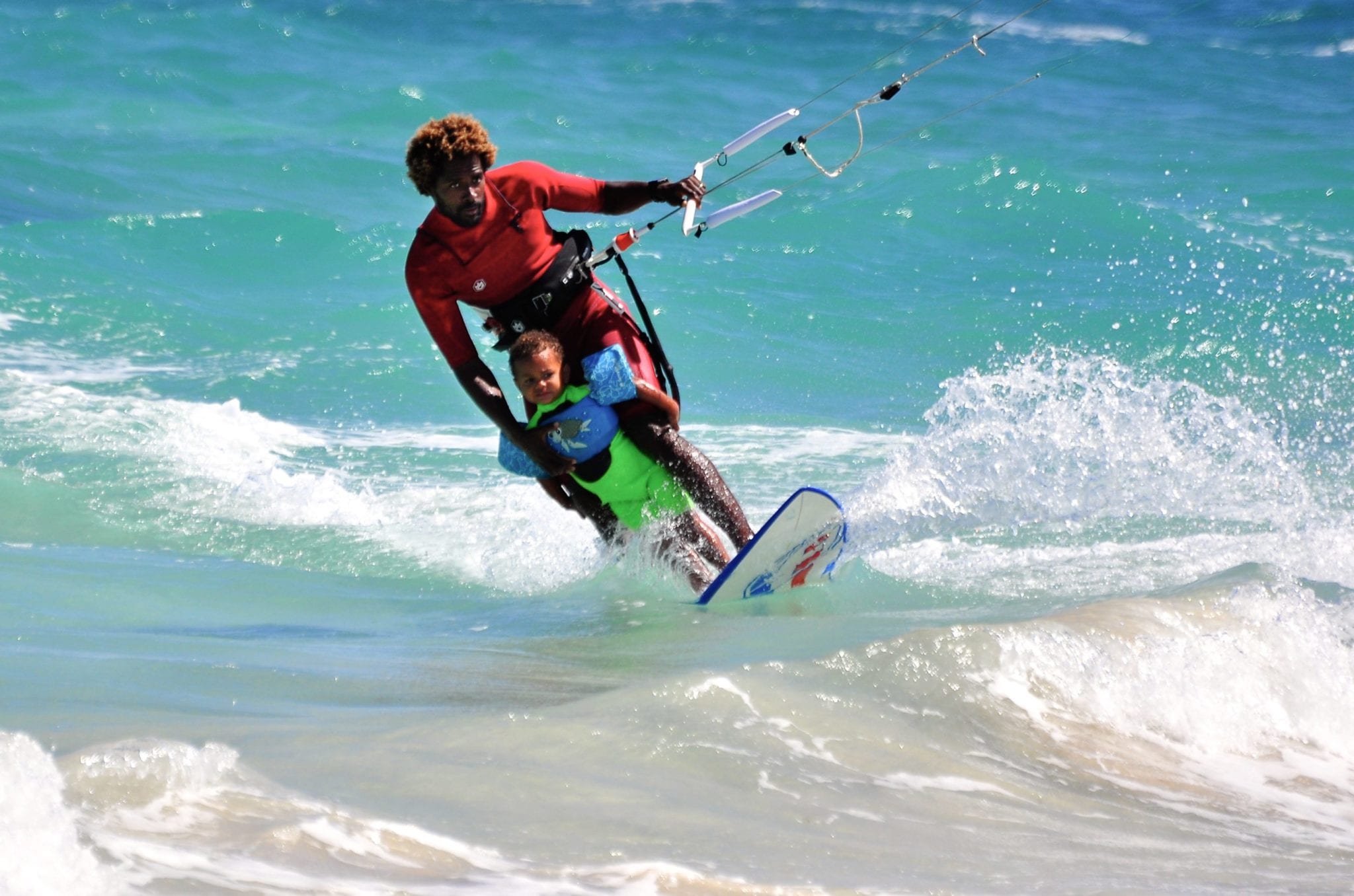
Mitu takes his son out on the water. // Photo Gabriele Rumbolo
It was different when I was a kid. I would tell my mama I go surfing, she would say, “What surfing ”” you can take some waves, but what’s the wave gonna give you? If you go fish then we can eat dinner.” Back then the mindset was that surfing gets you nothing, but now it’s changed; I have my job and people can see that surfing and kitesurfing can bring money and make you a living.
How did you find your way to kitesurfing?
My passion for the sea comes from making small model boats as a child. I watched fishermen going by sail and how they could move with the pull of the wind rather than by engine. I see these big boats and I make my own model boats with wood and garbage bags. I put them in the water and learned the basics of wind direction. When I first started the problem was getting them to sail upwind; the boat would turn around because it don’t have the weight on the bottom. So one day I swim really close to a real boat, and I say, “ahh it has something underneath.” Then I start to attach some weight to a keel, and then the boats started to work ”” all my passion it comes from there.
So you got your start as a boat designer?
Yeah, I guess you could say something like that. I liked to put my boats in the water to see how I can sail and control the boat. I started building catamarans and trimarans, but these could go fast and often I would lose them because I couldn’t keep up by swimming alongside. It was around that time that I first started in the waves with bodyboarding. My first bodyboard was a sack filled with old water bottles packed inside for flotation and I learned to ride the waves with my friends.
One day we discovered an old windsurfing board in the garbage outside a windsurfing station at our beach. We were really small, but we’d all try to surf with this huge board, learn to drag our foot in the water for a fin and to turn it in the waves. I began to use a plastic sack as a sail, sit on top of the board to try to windsurf, but I could only go downwind. And then this guy sees me and says, “Ahh Mitu come, I gonna show you how to windsurf.” So this guy, he cut the sail and the mast and make the sail smaller for me. It was not so easy, but in one day I learned how to go, come back, and stay upwind. I would spend all day on the water just playing with my little sail and I learn really fast. I would use the windsurfer to keep up with my sailboat models, retrieve them and send them back. I was 11 at the time, but with time I got a new board and started using the harness and footstraps and learned how to jump.
You were getting started as a pro windsurfer when kiting was invented. How did kiting come to Cabo Verde?
The first kite I saw was a French guy with a two-line traction kite just for the beach. I watched him get dragged downwind and if the kite got in the water he was done, he was swimming. I see this kite, I go “whoa nice,” I want to try but this kite was really expensive so nobody want to let you borrow it. Then we had a competition on Sal and Rafael Salles and the first pros come to the island. At that time I worked in one of the windsurfing schools and there was a guy who wanted to learn, so he says, “Ok Mitu, we learn together, I help you and you help me.” I was 17, so I learned really quick. We didn’t have the internet to learn, so we had to teach ourselves and there was much swimming because we didn’t know how to relaunch the kite and it was a two line Wipika. Without depower, there were some big crashes.
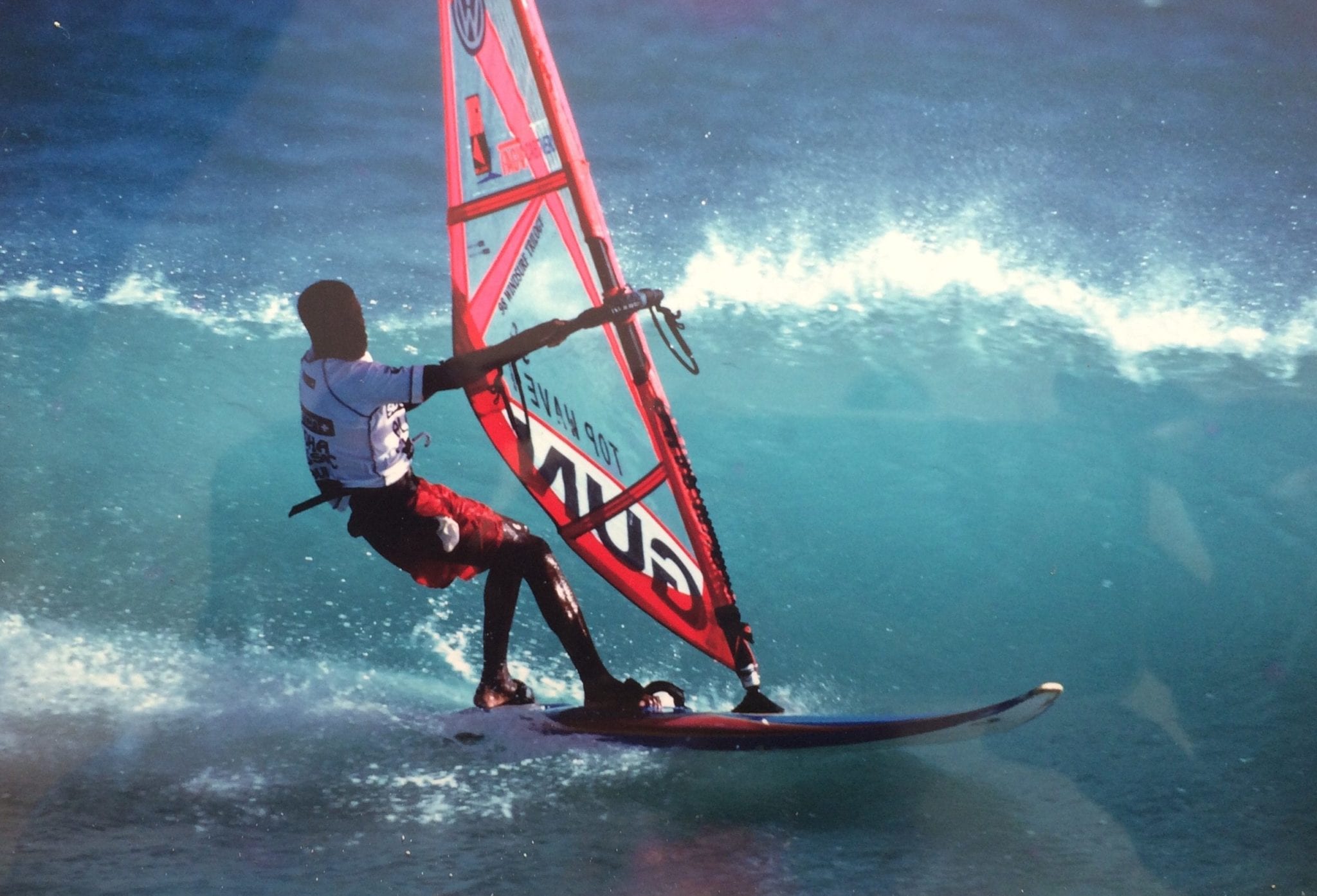
Mitu’s windsurfing career was more than just a placeholder before kitesurfing; the crossover fueled his early kite progression. // Photo Monteiro Family
What was your early progression?
I learned fast, but after one month I stop again because it was too easy, I had learned all the tricks: back loop, front loop and deadman. So, I focused on windsurfing again. But then I see Mark Shinn do some no footers and I want to do the same, so I start again. The biggest influence was from people coming to the island and if you wanted to learn a new trick you had to figure out a lot of it by yourself. I remember the first KPWT Wave Masters event in 2003. It was the first wave kite competition and everyone was still using twin tip boards in the surf but there was this one blond American guy (later on our drive we narrow this guy down to California’s Peter Trow) was using a surfboard, you know with straps in the wave, and riding really good. This guy was good motivation to change the board, for me it was not so easy because I had my twin tip, so I started to use my surfboard to kite waves.
Most the time I was putting a lot of things from windsurfing and surfing into kiting. In kiting we have the shuvit, but in windsurfing we have the willy skipper. I guess I started to focus on strapless early on because I only had my surfboard and it wasn’t until I started with F-One that I used a surfboard with straps for the first time.

Mitu’s early years on the F-ONE team, dropping in on Sal, Cabo Verde. Photo Courtesy F-One
So in some sense your progression was influenced by what you had, as much as what you didn’t?
I think I have more motivation for kiting when I start with the surfboard. With the surfboard I tried to do the tricks I do with the windsurf because I did a lot of freestyle windsurf. And these tricks I try to put on the kite. You know, shuvit, try to to jump without the straps. It wasn’t so easy because I was using C-kites. They have no depower so it was really difficult to keep the board on your feet. But then I did one and I say “wow, it’s possible,” and then I try to improve. Every day I discover new things and then I try to put the pieces together on the wave. Now you can watch a lot of surfing moves and you can put them into kiting. With windsurfing it was a little easier. Josh Angulo had moved to Sal from Hawaii and he taught me a lot because we spent a lot of time windsurfing together. There were competitions and the sport was more defined. In kitesurfing I didn’t have someone to watch, I had to make it up myself.
In terms of evolution of the gear, how does the production kitesurfing board compare to custom?
If you have a custom board there are advantages because you can make it lighter, you can get the exact shape ideal for you, but if I’m at a competition and I break my board then it takes time to get a new one. Since I ride F-One production boards I just take another one off the shelf and have no problem adapting. I push myself to ride my 5’8” ”” I can do everything, kitesurf waves, freestyle strapless and I can even surf without kite. Maybe that size is not the best at Teahupo’o, but it’s possible. You could have five boards for each condition, but I prefer having one and focusing on improving myself to use one board for all conditions.
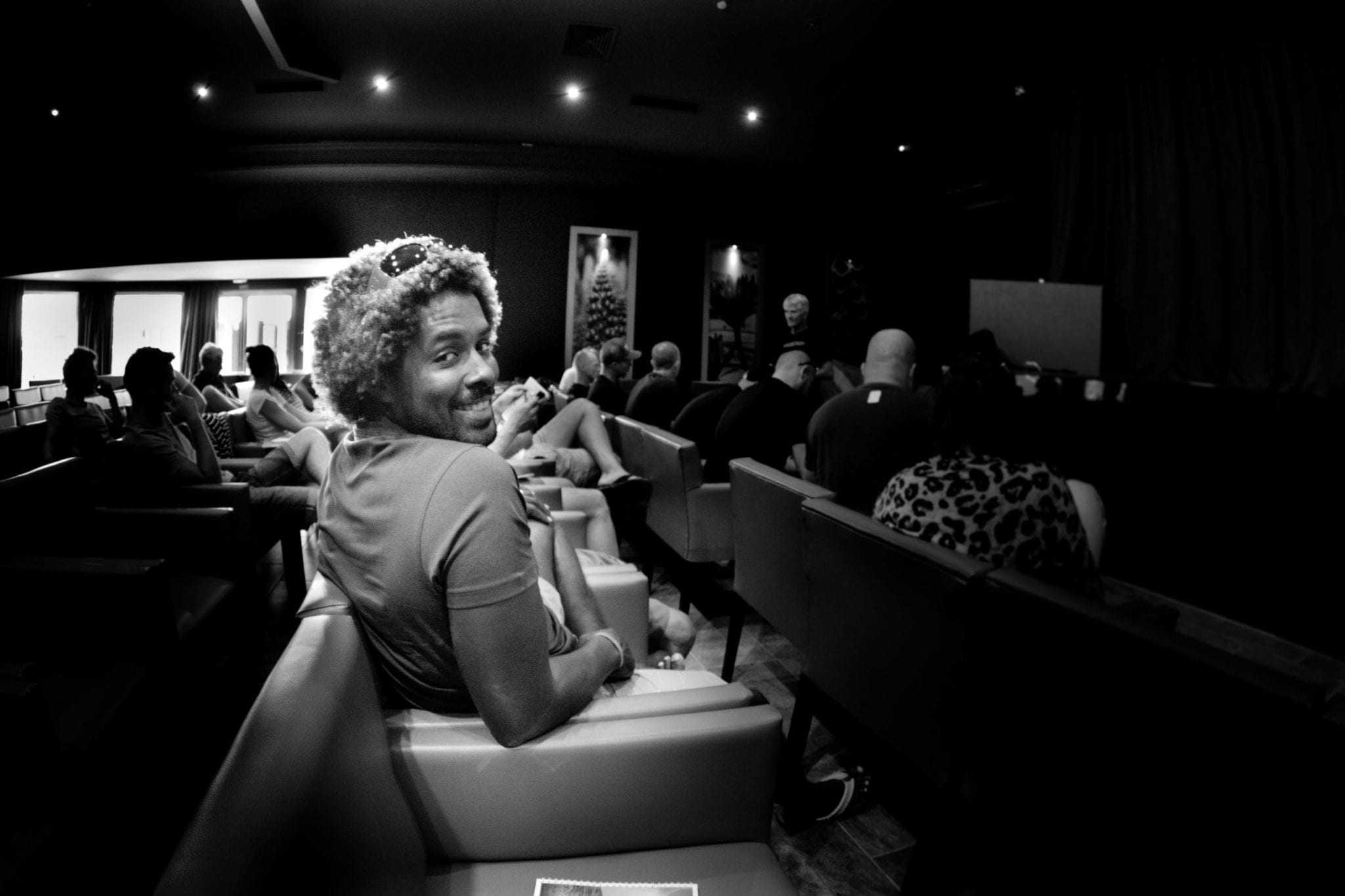
Mitu is all smiles in the midst of a product presentation at F-One’s importer meeting. // Photo Brendan Richards
I’ve seen photos of you at Teahupo’o locked into some serious caverns. Barrel riding has come a long way in the last six years, but do you think at some point we will see someone talented have disastrous consequences in powerful waves?
Yeah, for sure it’s possible. The first time I went to Teahupo’o was in 2013 to make a movie. I was staying with my friend Manutea. He has this house near the water that moves with the vibrations of the wave. It’s dark at night but you can hear Teahupo’o exploding just offshore. After a couple days the wind lined up with a big swell and I dropped in on my first wave with my 8m ”” it was crazy, you feel it go really fast but you stay in the same position because of all the water coming up the face. I try to start make the barrel, going more and more deep, but my lines get hung up in the lip and the kite goes down and I take the wave on my head. The wave pushed me towards the lagoon and ripped the kite into two, which was good, but when I finish the washing machine and come up I couldn’t release the kite because of a tangle on the harness and chicken loop. That was really scary. I drank a lot of water, and I thought I was going to die there. Normally the tow-in guys don’t rescue kiters because the lines can get stuck in the jet, but my friend came and rescued me.
After this wipeout I feel more comfortable ”” I have more adrenalin, I want to go more deep. It was a dream to be there, so I was really motivated to get back out there but at the same time it makes me think about the risks we take. When you watch tow-in, the guy has lifejacket, impact vest and helmet. I was out there with my shorty and my harness ”” I took a lot of risk, but I didn’t think about because I was excited to go in the water.
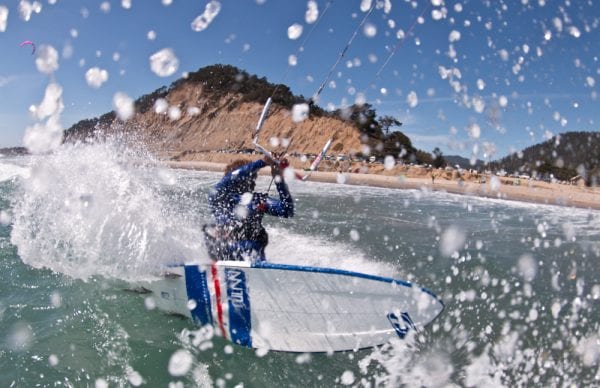
Visiting dignitaries are fairly rare at Waddell these days, Mitu quickly makes himself at home. // Photo Brendan Richards
You are the point of origin for the rodeo trick, where you put the board between your legs. Why do you do this?
Everything has purpose, the rodeo is not because I wanted to do like that, but out of function. When you surf, you’re just waiting for the wave at the peak, but with kitesurfing you are moving. In Cabo Verde, at Punta Preta the wind is sideoff and sometimes you have to launch out of the wave because you have a lot of speed. Controlling the kite with one hand and holding the board with the other is hard, so I start putting the board between my legs and I can control the landing. This is the reason for this trick. All the tricks I do, is because it is going to help me somewhere, for example landing the shuvit with fins in the front. In Mauritius everyone was breaking the fins, but when I see the reef I just slide the board around and I can go in shallow water.
You were competing in the PKRA when kiting’s only legitimate surf tour was born. What was that like?
The idea for the KSP started in 2009 at the last stop of the PKRA in Australia. A lot of the surfers were not so happy because freestyle was the priority and the judges didn’t know much about scoring in the waves. Kristin Boese called a meeting and we talked about a new tour, a dream tour for kitesurfing. We decided to do something separate, to have wave-specific judges and to focus on locations with the best surf and we all agreed to do the first year without prize money to help the tour grow. All the stops were in paradise spots: Mauritius, Maui, Cabo Verde, Ireland and Portugal ””real wave spots. It was good but then it stopped because there wasn’t enough sponsor money. You need people and money to make it happen, but it just wasn’t the right time. Compared to surfing, kitesurf is a new sport and you need wind and waves which makes it more complicated to have a good contest. Now you have more people start to kite on the wave ”” slowly it will get bigger and bigger.
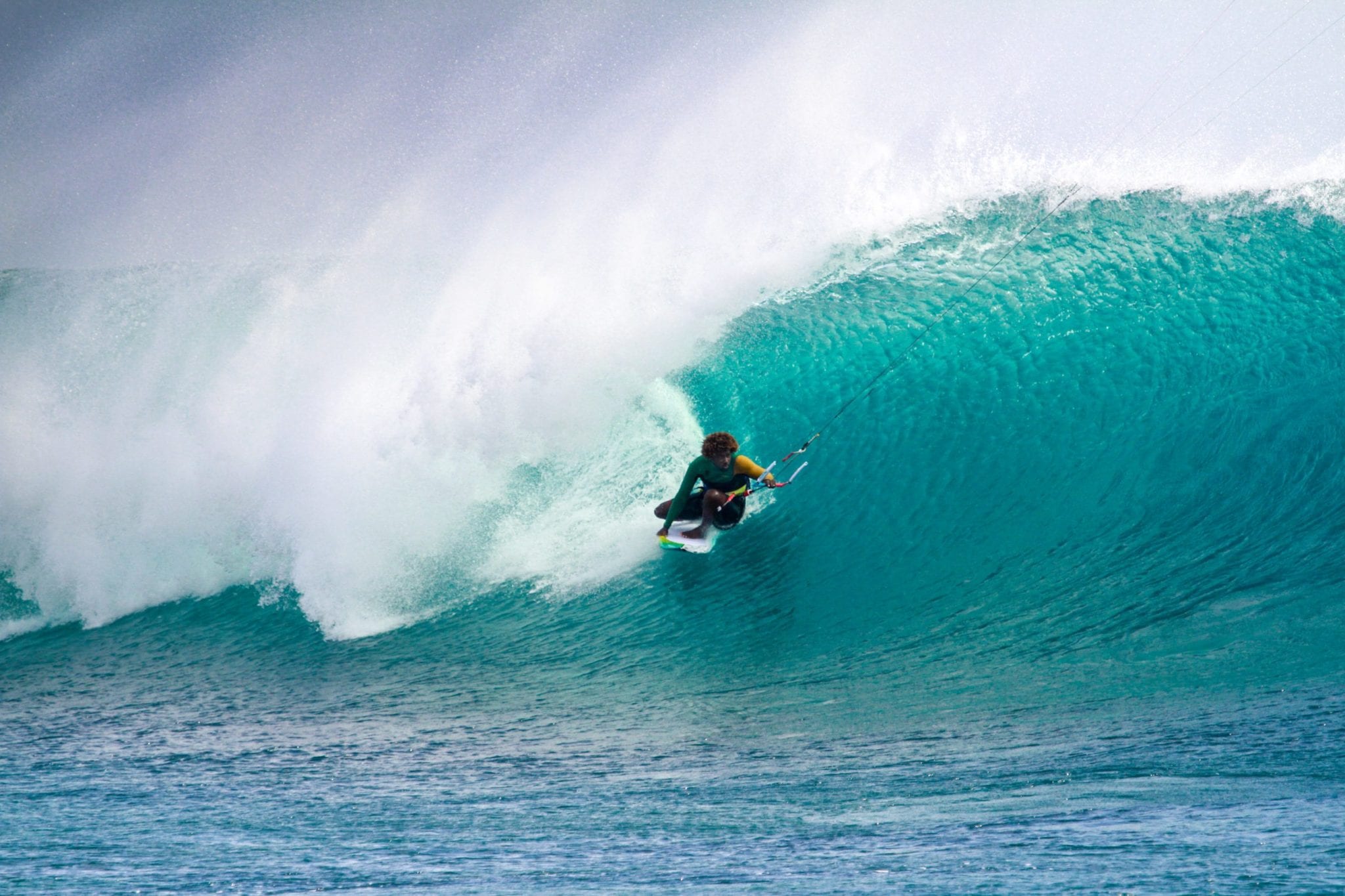
Drop-kneed with rail in hand, Mitu commits to a clean barrel at One Eye in Mauritius. // Photo Rou Chater
You have been with F-One for quite a long time, while other pro riders switch it up. How has this worked for you?
I’ve been with F-One for 10 years. When I first start they just give me some kites, but then I start to be more professional. Some brands have this rider this year, then another next year and I’ve had some other offers but it is important that I like the relationship. F-One is like a family but it’s also a job that comes with responsibility and you spend a lot of time together. Rafael, F-One’s owner, and Micka, come to Cabo Verde quite a lot and I see how much time it takes to test a product before it goes into production. Take my pro-model surfboard; we spent four years on prototypes before putting into production. It’s hard work ”” when Rafael comes to my home to test sometimes he spends six hours on the water. I have a sewing machine at my school, and Rafael might make some changes just to do one kite and then back to the water for more testing. It’s not so easy work because sometimes you improve a kite in one direction but lose in another. It’s more fun when we go on team trips, we’re always discovering ”” not just about kiting ”” and making documentaries about new places. It’s a good job and I’m happy to be part of this.
In addition to pushing the performance side of kitesurfing as a professional, you also own your own kite school in your hometown of Santa Maria, Sal, Cabo Verde. Besides money, what do you get out of owning a school?
I love to share my passion to other people. I teach some beginners when I have time, but more often I do wave clinics, coaching and advanced lessons. I discover a lot from my students because everyone has a different way to learn. Some professional riders are not able to teach, because to be a good instructor you have to think as a beginner, go through every single step and put yourself in their shoes. It is not simple, but worth it. I love to own a place where all the people there are sharing my own passion. I work hard to create a good product because there are plenty of kite schools, but the difference we make is building every part of the company in a professional way. It’s not easy; you must find the right partner, the right staff, the right place and the right gear. Our success is a combination of all these factors.
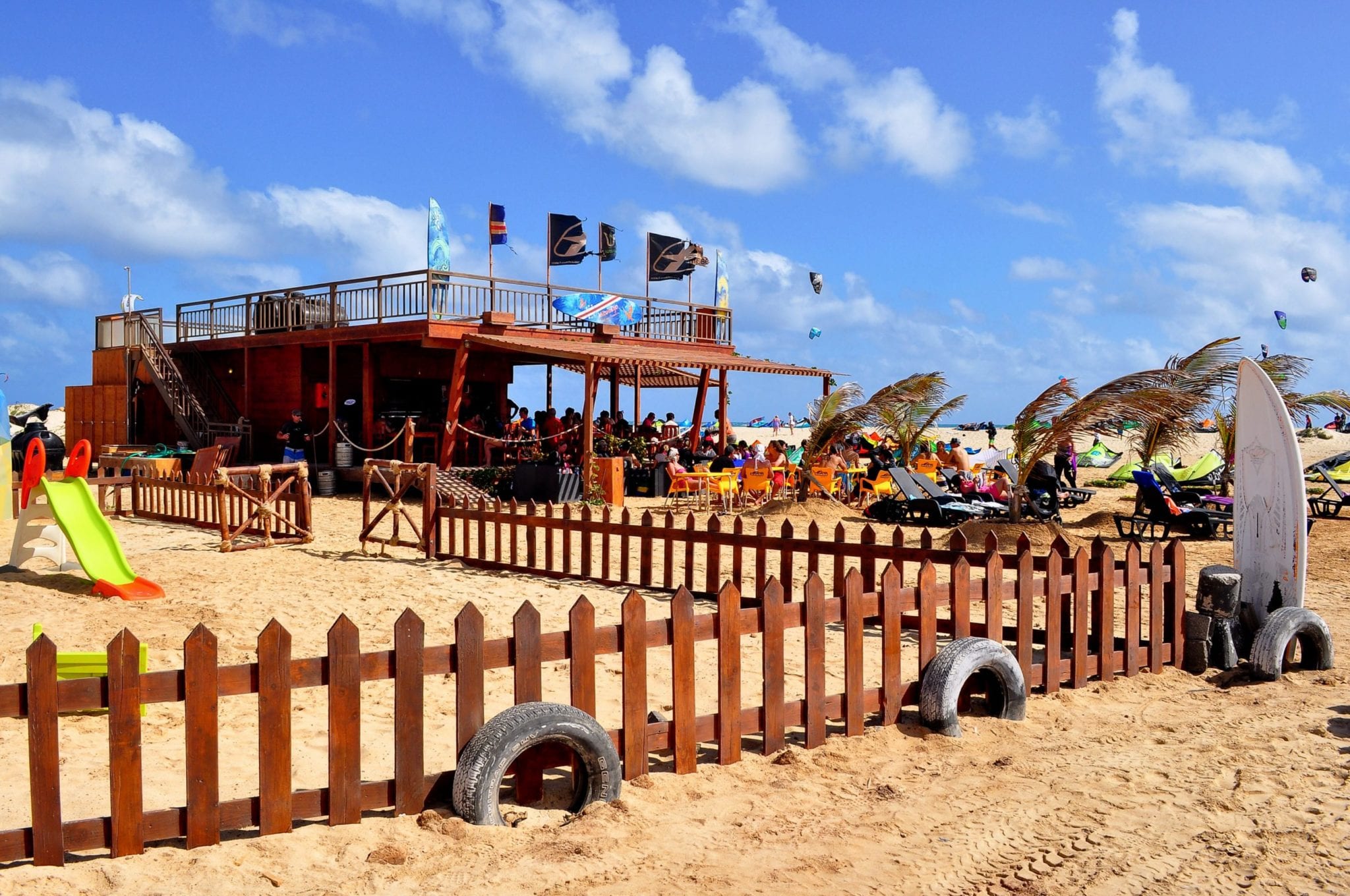
Mitu’s main kite center in his hometown of Santa Maria is a full service kite school, apres kite beach bar and all around destination kite center. // Photo Gabriele Rumbolo
Once in the water at Waddell, Mitu is both David and Goliath, launching technical aerials and strapless rotations with precision, yet smashing waves with the grunt force of an unrelenting freight train. As I watch Mitu tear apart the sandbars at Waddell it’s clear he’s a surfer at heart and I’m struck by the transformation from a quiet island boy off the coast of Africa to a kitesurfing icon traveling the world. Mitu has covered a lot of ground, yet he’s done this without ever leaving his roots. Mitu’s story makes me believe through sheer determination we can reshape ourselves and the world around us for the better.
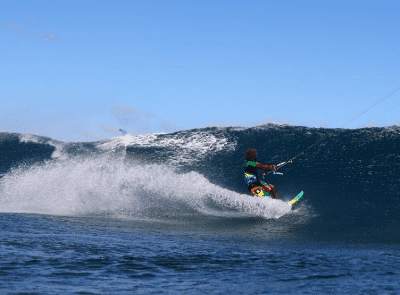
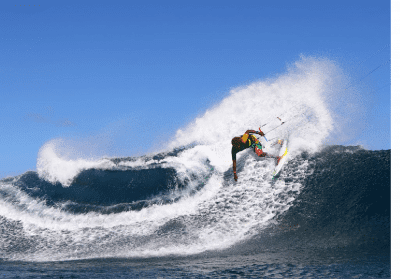


Words & Interview by Brendan Richards
This article was featured in Winter 2015 issue of Tkb.


